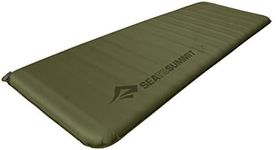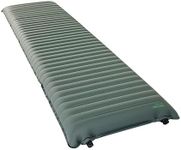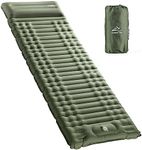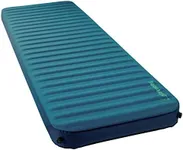Buying Guide for the Best Backpacking Sleeping Pads
Choosing the right backpacking sleeping pad is essential for a comfortable and restful night outdoors. The right pad not only provides cushioning from the hard ground but also insulates you from the cold, making a big difference in your overall camping experience. When picking a sleeping pad, it's important to consider how you'll be using it, the conditions you'll face, and your personal comfort preferences. Understanding the key features will help you find a pad that matches your needs and ensures you wake up refreshed and ready for adventure.WeightWeight refers to how heavy the sleeping pad is when packed. This is important because every ounce counts when you're carrying all your gear on your back. Lighter pads are easier to carry and are best for long hikes or trips where minimizing pack weight is crucial. Heavier pads may offer more comfort but can be tiring to carry over long distances. If you plan on hiking long distances or want to keep your pack as light as possible, look for ultralight pads. If comfort is more important and you don't mind a bit of extra weight, a heavier pad might be suitable.
Packed SizePacked size is how small the pad becomes when rolled or folded for storage. This matters because space in your backpack is limited. Smaller packed sizes are easier to fit into your bag and leave more room for other essentials. Pads can range from very compact, about the size of a water bottle, to larger rolls that take up more space. If you have a small backpack or need to save space, choose a pad with a compact packed size. If space isn't a big concern, you can opt for a larger pad.
R-Value (Insulation)R-Value measures how well the pad insulates you from the cold ground. A higher R-Value means better insulation, which is important for staying warm, especially in cold weather. R-Values typically range from about 1 (minimal insulation) to 7 or more (excellent insulation). For summer camping, a lower R-Value is usually enough. For spring, fall, or high-altitude trips, look for a mid-range R-Value. For winter or very cold conditions, choose a pad with a high R-Value to prevent losing body heat to the ground.
ThicknessThickness is how tall the pad is when inflated or unrolled. Thicker pads generally provide more comfort and cushioning, which can be important if you sleep on your side or are sensitive to hard surfaces. Pads can range from less than an inch to several inches thick. Thinner pads are lighter and pack smaller but may be less comfortable. Thicker pads are more comfortable but can be bulkier and heavier. Consider your sleeping style and comfort needs when choosing the right thickness.
Type (Foam, Air, Self-Inflating)Sleeping pads come in three main types: foam, air, and self-inflating. Foam pads are simple, durable, and lightweight, but can be less comfortable. Air pads are lightweight and pack small, but require inflation and can be punctured. Self-inflating pads combine foam and air, offering a balance of comfort and convenience, but are usually heavier and bulkier. If you want simplicity and durability, foam is a good choice. For the best packability and comfort, air pads are ideal. If you want a mix of both, consider self-inflating pads.
Length and WidthLength and width refer to the dimensions of the pad when laid out. This is important for ensuring the pad fits your body and sleeping style. Standard pads fit most people, but longer or wider options are available for taller or larger individuals, or for those who move around a lot in their sleep. If you are tall or like extra space, look for longer or wider pads. If you want to save weight and space, a shorter or narrower pad may be enough, especially if you only need to cushion your torso.
DurabilityDurability is how well the pad stands up to rough use, punctures, and wear. This is important if you'll be camping on rocky or uneven ground, or if you want your pad to last for many trips. More durable pads are made with tougher materials and thicker fabrics, but may be heavier. Less durable pads are lighter but can be more easily damaged. If you expect rough conditions or want a long-lasting pad, choose one with higher durability. For gentle use or if weight is your top concern, a lighter, less durable pad may be fine.















